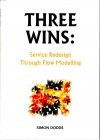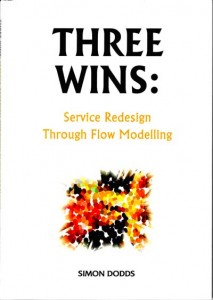Three Wins: Service Redesign Through Flow Modelling, by Simon Dodds
A review of Simon Dodds' book which examines the use of simulation in the redesign of a vascular surgery.
MASHnet is proudly part of The Association of Professional Healthcare Analysts


A review of Simon Dodds' book which examines the use of simulation in the redesign of a vascular surgery.
By Simon Dodds, 2006. Kingsham Press, Chichester.
ISBN 1-904235-54-9
Price: £16.95. Soft back. 71 pages.
Review by Martin Pitt
Simon Dodds is a vascular surgeon with an unusual background. In addition to his medical training, he is qualified and experienced in computer science and has a working knowledge of process re-engineering.
This book charts Dodd’s award winning project of transforming the leg ulcer referral service at Good Hope Hospital in Sutton Coldfield. Rather than dwelling on the hard aspects of process re-design, however, the content majors on the softer sides of inducing radical change in a system emphasising the importance of team building and creating trust and commitment. In this the book draws on the work of management scientists such as Belbin and Bridges, looking at the necessary conditions for successful transformation. Only towards the end does Dodds tackle the application of his simulation modelling techniques in the redesign process and shows how this fits into the staged re-development of services.
The book is presented as a narrative, stepping through the key stages of process re-design applying the lessons of software engineering to process engineering. The ‘win-win-win’ of the title refers to the gains of re-design in terms of improvements in:
This is very much a book for those who want to see examples of successful transformation and learn lessons of application. It succeeds because it is a practical approach, bedded in the experience of his own transformation of the leg ulcer service at Good Hope. Each stage of the story is underpinned by inset panels illustrating experiences from this innovative project. Dodds is clearly keen to spread the good word and the good work. The book has a positive, sometimes evangelical, style. But this does not grate, rather is refreshing in the context of an organisation – the NHS-where change of any sort evokes phrases such as ‘wading through treacle’ and ‘banging your head against a brick wall’.
Inevitably questions arise from a critical reading of the text. How, for example, is the advocated approach relevant when the ‘win-win’ benefits are not so obvious. The reality of many situations of service provision is that of trade-off, where typically gains in benefit are off-set by costs in resources. Here there are unavoidable judgements needed to deal with these trade-offs. Despite this, however, there is a clear potential that many ‘win-win’ possibilities do exist in healthcare and are yet to be engaged with for reasons of inertia.
It is also important to highlight the challenges that exist for departments which do not have the benefit of a champion such as Simon Dodds with his unusual mix of skills. It is the bridging of information from the problem holders to the system designers that is so often where the breakdowns occur – clearly an area where much more remains to be accomplished.
This is an engaging and challenging book on health service re-design which will be of interest to anyone concerned with the hard practical issues of instilling change and the role that modelling and simulation can play as an embedded part of this process. Dodds does not claim to provide all the answers in this slim volume and clearly has a great deal more to say on the issues that he introduces. We can only hope for further publications in the future.